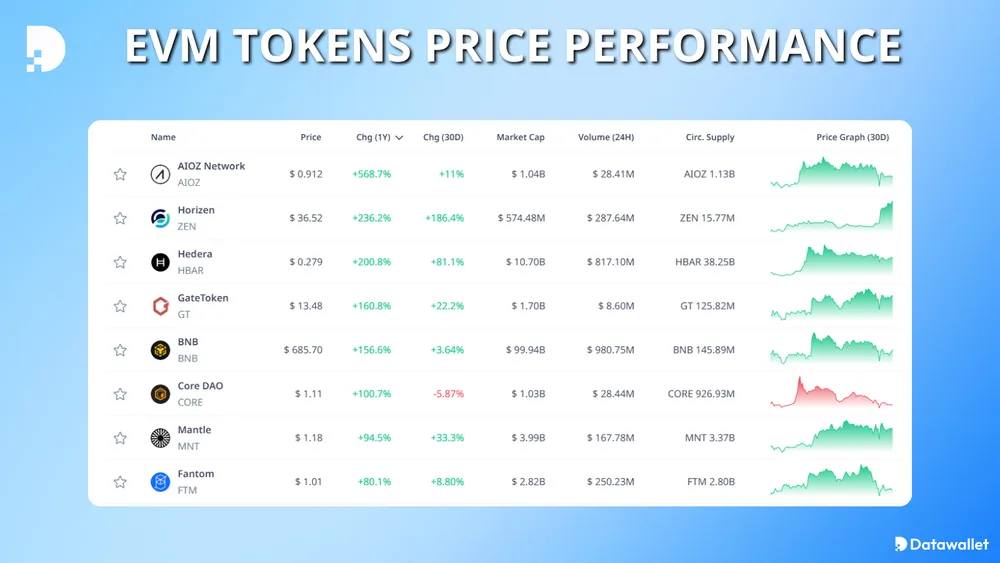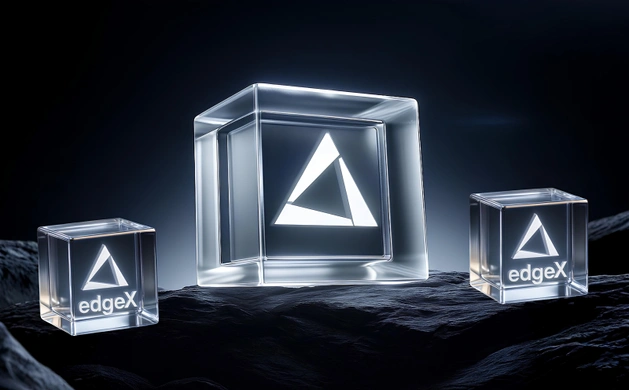What are EVM Chains?

Summary: EVM chains are blockchain networks that support the execution of decentralized applications using Ethereum’s programming framework (Solidity) and developer tools.
Combined, these chains hold over $100 billion in on-chain value across protocols accelerating technological progress in decentralized finance, gaming, and crypto as a whole.
As layer 1, 2, and 3 networks become more interoperable, EVM technology serves as a unified framework, enabling developers to build and deploy decentralized applications seamlessly across multiple chains.
What is an EVM Chain?
An EVM chain is a blockchain that replicates the Ethereum Virtual Machine's environment, enabling compatibility between networks. These chains use Solidity, the programming language for smart contracts on Ethereum, making it easy for developers to fork protocols across networks.
EVM chains support ERC-20 tokens, NFTs, decentralized exchanges, lending protocols, prediction markets and liquid staking platforms among other applications. These blockchains also often allow for easier cross-chain interoperability, favoring easier bridging of assets.
Unlike EVM equivalence, which mirrors Ethereum's functionality exactly, EVM compatibility allows variations and optimizations while remaining compatible with Ethereum tools. ChainList offers a directory of EVM chains and their RPC endpoints for easy network connection.

What Is the Ethereum Virtual Machine (EVM)?
The Ethereum Virtual Machine (EVM) is the decentralized computation engine that executes smart contracts on the Ethereum blockchain and compatible networks, forming the backbone of EVM chains.
It processes instructions written in the primary programming languages for Ethereum: Solidity, Vyper, and Yul, which are specifically designed for creating smart contracts. These languages compile into bytecode, a low-level representation that can be executed by all network nodes.
The EVM ensures consistent, trustless execution of code by applying the same computational rules and gas fees across every transaction, a critical feature for synergy across EVM chains.

Popular EVM Blockchains
Popular EVM blockchains represent the most widely adopted and innovative networks, each striving to push the boundaries of blockchain through advancements like parallelization, zero-knowledge proofs, or unique consensus mechanisms. Here are the most popular ones:
- Ethereum: The first EVM blockchain that pioneered decentralized finance and NFTs, now supporting largest ecosystem of dApps but faces high gas fees and slower transaction speeds.
- BNB Chain: Previously Binance Smart Chain, BNB Chain powers projects like PancakeSwap, a Uniswap fork that highlights EVM compatibility power.
- Polygon (POL): Transitioned from MATIC, Polygon enables ZK rollups, sidechains, and other scaling technologies, handling thousands of transactions at a fraction of Ether’s costs.
- Arbitrum: A layer 2 with Optimistic Rollup technology, enabling Ethereum dApps to operate with significantly lower fees and faster execution.
- Avalanche: An EVM-compatible chain with an upcoming "Avalanche9000" upgrade, with hyper focus on developers with a $40 million grant and additional rewards for builders.
- Berachain: Built on Cosmos SDK, Berachain’s Proof-of-Liquidity (PoL) consensus mechanism directly ties network security to liquidity provisioning.
- Monad: With $244 million in funding it targets 10,000 transactions per second (TPS), Monad is developing a parallelized EVM execution system to address bottlenecks in scalability.

EVM Chains Statistics
EVM chains dominate crypto, showcasing diverse usage patterns and economic metrics. Below is a breakdown of TVL, network activity, stablecoin supply, and market ROI for EVM networks.
Total Value Locked (TVL)
Currently, 226 EVM chains hold a combined TVL of $100 billion, with Ethereum leading at a 67.92% market share. Other leaders include Tron (7.33%), BNB Chain (5.62%), and Base (3.62%), while newcomers like Hyperliquid's L1, Zircuit, and Hedera are among the fastest-growing.

Active Addresses
Tron and Base host the most active addresses, each measuring about 2.3 million daily users.
BNB Chain follows with 1 million active wallets, doubling Ethereum’s 0.5 million, while new EVM chains including Scroll show early adoption with 10,000 to 30,000 daily wallets.

Stablecoins
Stablecoins have surged in adoption, with Ethereum leading the way by hosting nearly $200 billion in assets, predominantly in ERC-20 versions of USDT and USDC.
TRON ranks second, managing $70 billion, driven primarily by its extensive supply of TRC-20 USDT.

Price Performance
Among top-performing EVM tokens, AIOZ from the AIOZ Network leads with a +670% price increase in the past year. GateToken (GT) from GateChain is up +161%, and Fantom’s rebranded Sonic token (ticker S) has grown nearly 100%.

Best EVM Crypto Wallet
MetaMask is currently viewed as the best wallet for EVM-compatible blockchains, trusted by over 30 million users worldwide. Primarily used as a browser extension, it also offers a mobile app, ensuring accessibility across desktop and mobile platforms.
MetaMask's standout features include its ability to switch between EVM networks and interact with non-EVM chains through MetaMask Snaps. For developers, it excels in facilitating interactions with Ethereum Sepolia testnet and offering compatibility with IDEs such as Remix.
The wallet also allows users to customize RPC endpoints and adjust gas fees through an intuitive, minimalistic interface that balances advanced functionality with simplicity. Alternatively, users can also choose from other top EVM wallets like Trust Wallet, Coinbase Wallet, and WalletConnect.

Examples of non-EVM Compatible Chains
Non-EVM compatible blockchains operate independently of the Ethereum Virtual Machine, often featuring unique architectures and ecosystems that do not conform to Ethereum’s standards.
- Bitcoin (BTC): The first blockchain, Bitcoin uses the UTXO model and focuses on secure, decentralized value transfer, lacking native smart contract support.
- Solana (SOL): A high-performance blockchain with Proof of History (PoH) consensus. Development on Solana requires Rust and C programming languages.
- Cardano (ADA): Created by one of Ethereum's co-founders, Charles Hoskinson, Cardano is powered by Ouroboros Proof of Stake, and supports Haskell-based smart contracts.
- Cosmos (ATOM): A network of independent blockchains using the Tendermint consensus and Inter-Blockchain Communication (IBC) protocol, built for interoperability.
- Aptos (APT): A blockchain leveraging the Move programming language, created for safe and flexible asset management, and parallel execution to optimize scalability.
Bottom Line
If we could summarize EVM chains simply, they are blockchain networks built to work with Ethereum’s Virtual Machine, enabling the same type of applications but on different systems.
For someone less familiar with the tech, think of them as platforms that speak Ethereum’s language but run on their own unique chains and much cheaper network fees.
They have grown in popularity because the crypto market has matured, and using Ethereum's existing VM is more logical than creating a separate one that will most likely go unused in 2 years.
%2520(1).webp)
Written by
Antony Bianco
Head of Research
Antony Bianco, co-founder of Datawallet, is a DeFi expert and active member of the Ethereum community who assist in zero-knowledge proof research for layer 2's. With a Master’s in Computer Science, he has made significant contributions to the crypto ecosystem, working with various DAOs on-chain.



.webp)
.webp)
%2520(1).webp)



